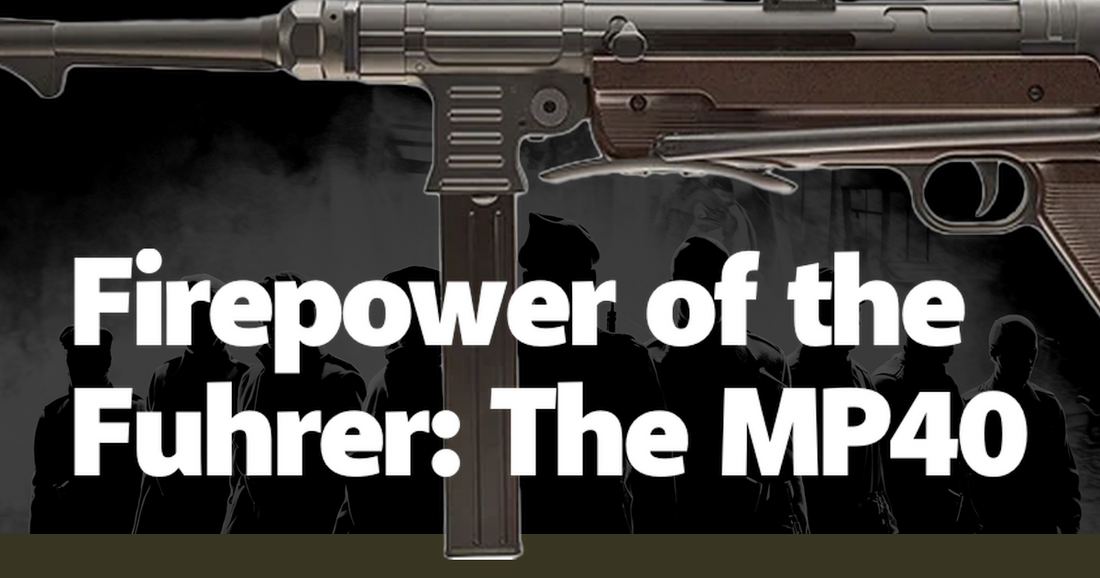The MP40 submachine gun, often synonymous with the German Wehrmacht during World War II, is an iconic symbol of the Third Reich's military prowess. Known colloquially as the "Schmeisser" by Allied forces, the MP40 was a technological marvel of its time, blending simplicity with deadly efficiency. Its sleek, compact design made it an ideal weapon for the close-quarters combat that characterized much of the conflict. The MP40's development was driven by the need for a reliable, easy-to-manufacture submachine gun that could be mass-produced to equip the expanding German army. This weapon not only met those requirements but also left an indelible mark on the battlefield, shaping the tactics and outcomes of numerous engagements.
The MP40 was designed by Heinrich Vollmer and was based on the earlier MP38 model. It featured a telescoping bolt system that allowed for a shorter overall length without sacrificing barrel length, thus maintaining accuracy. Chambered for the 9mm Parabellum cartridge, the MP40 had a relatively low rate of fire at around 500 rounds per minute. This slower rate of fire was a deliberate design choice, aimed at improving control and conserving ammunition during prolonged engagements. The weapon's simple blowback operation and open-bolt design made it remarkably easy to maintain and repair, even under the harsh conditions of the front lines. These features made the MP40 a favorite among German soldiers, who appreciated its reliability and ease of use.
One of the most compelling aspects of the MP40 was its role in shaping German infantry tactics. The weapon was ideally suited for the Blitzkrieg strategy, which emphasized speed, surprise, and concentrated firepower. German soldiers armed with MP40s could rapidly advance and clear enemy positions, using the weapon's superior handling to dominate in close-quarters combat. The MP40's folding stock and compact size made it particularly effective in urban warfare, where maneuverability and the ability to quickly transition between firing and moving were crucial. Stories from the Eastern Front and the Battle of Stalingrad often highlight the MP40's effectiveness in the brutal, house-to-house fighting that characterized these engagements.
Despite its many advantages, the MP40 was not without its drawbacks. The weapon's reliance on the 9mm Parabellum cartridge meant that it lacked the stopping power of heavier-caliber firearms. This limitation was particularly evident in the vast, open spaces of the Eastern Front, where engagements often occurred at longer ranges. Additionally, the MP40's 32-round magazine, while generous for its time, could be quickly depleted in the heat of battle, necessitating frequent reloads. Anecdotes from veterans often recount the frantic moments of reloading under fire, a testament to the intense and unforgiving nature of wartime combat. Nevertheless, the MP40's overall performance and reliability ensured its continued use throughout the war.
The MP40 also found its way into the hands of various resistance groups and partisan fighters across Europe. Captured MP40s were highly prized by these irregular forces, who valued the weapon's robustness and ease of use. In the hands of the French Resistance, Polish partisans, and Yugoslav Partisans, the MP40 became a tool of insurgency, disrupting German supply lines and ambushing patrols. These stories of resistance fighters wielding MP40s against their occupiers add a layer of complexity to the weapon's legacy, illustrating how it was both a symbol of oppression and a tool of liberation. The MP40's presence in these diverse hands underscores its widespread impact and the far-reaching consequences of its design.
The legacy of the MP40 extends beyond World War II, influencing the design of subsequent submachine guns and personal defense weapons. Its emphasis on simplicity, reliability, and ease of manufacture set a standard that would be emulated by post-war designers. The Soviet PPS-43 and the Israeli Uzi are just two examples of weapons that drew inspiration from the MP40's design principles. The MP40's impact is also evident in popular culture, where it frequently appears in films, video games, and historical documentaries. This enduring presence in media serves as a reminder of the weapon's iconic status and its role in shaping the course of 20th-century warfare.
In the modern era, the MP40 is a sought-after collector's item, with surviving examples fetching high prices at auctions and in private sales. Military historians and enthusiasts prize the MP40 for its historical significance and engineering excellence. Restored MP40s are often displayed in museums and at reenactment events, where they serve as tangible links to the past. The weapon's continued fascination among collectors and historians speaks to its enduring legacy and the profound impact it had on those who wielded it and those who faced it in battle. The MP40's story is a testament to the complex interplay of technology, tactics, and human experience in the crucible of war.
In conclusion, the MP40 submachine gun stands as a defining artifact of World War II, embodying the technological innovation and tactical doctrines of the German Wehrmacht. Its design, performance, and widespread use left a lasting imprint on the battlefield and in the annals of military history. From the streets of Stalingrad to the forests of Europe, the MP40 was a weapon that shaped the experiences of countless soldiers and resistance fighters. Its legacy continues to be felt today, both as a subject of historical study and as an enduring symbol of the era. The MP40's story is a compelling chapter in the broader narrative of 20th-century conflict, offering valuable insights into the evolution of warfare and the human condition.

